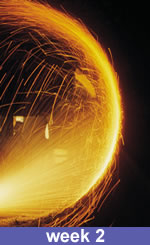USING A SCANNER
CONCEPT
Scanners are used to convert images into the digital format. Once images have been scanned they can easily be edited and manipulated.
USING A SCANNERS
Make sure that the scannner is turned on before the computer. If the scanner is not turned on first your computer may not recognize it.
The scanner works with a special software program (driver) that interfaces between the scanner and the computer. Place the image face down on the scanner. Click on the preview or pre-scan button.
Look on your computer screen and you will see a small image of what your final scan will look like. In this program, before you scan, you can adjust the scan area, and more importantly, the resolution of the scan.
The unit of measure for images and scanning is DPI or dots per inch. The greater the DPI the greater the quality of the scan. The greater the DPI, the more disk space will be used to save the image. Most scanners these days will scan up to 1400 DPI. How many DPI for Internet images? 72 DPI is all that is needed for the Internet.
HOW TO MODIFY IMAGES
After you scan the image, the image must be stored on the hard disk. To be able to edit or modify the image you must use a photo editing program. Programs like Adobe Photoshop or Jasc Paint Shop Pro or even simple utility programs like LView Pro will enable you to edit images. In our course we will use Microsoft Photo Editor.
SAVING FILES
There are dozens of different of image formats. Examples are EPS, TIFF and JPG. Most are non-proprietary formats and allow files to be read between applications. The most widely used image format on the Internet is JPEG. JPEG, however, is a "lossy" format. This means that image information is discarded each time the image is saved, for the purpose of reducing the file size of the image.
If you mean to use the image immediately on a Web page, go ahead and save the scanned image in the JPEG format. If, however, you wish to archive the image, with the intention of resizing, cropping or adding image effects at some future time, a "lossless" bitmap format such as BMP or TIFF is more appropriate.
COMMON PROBLEMS AND TROUBLESHOOTING
The most common problem in scanning images is setting the resolution too high. Scanning one image set to a very high resolution could require as much 30 MB just to store one image. That same image stored at a lower resolution might require only 30 KB of space.
Manipulating a huge image file draws heavily on your computers resources as well. This can often lead to your image editor crashing.



